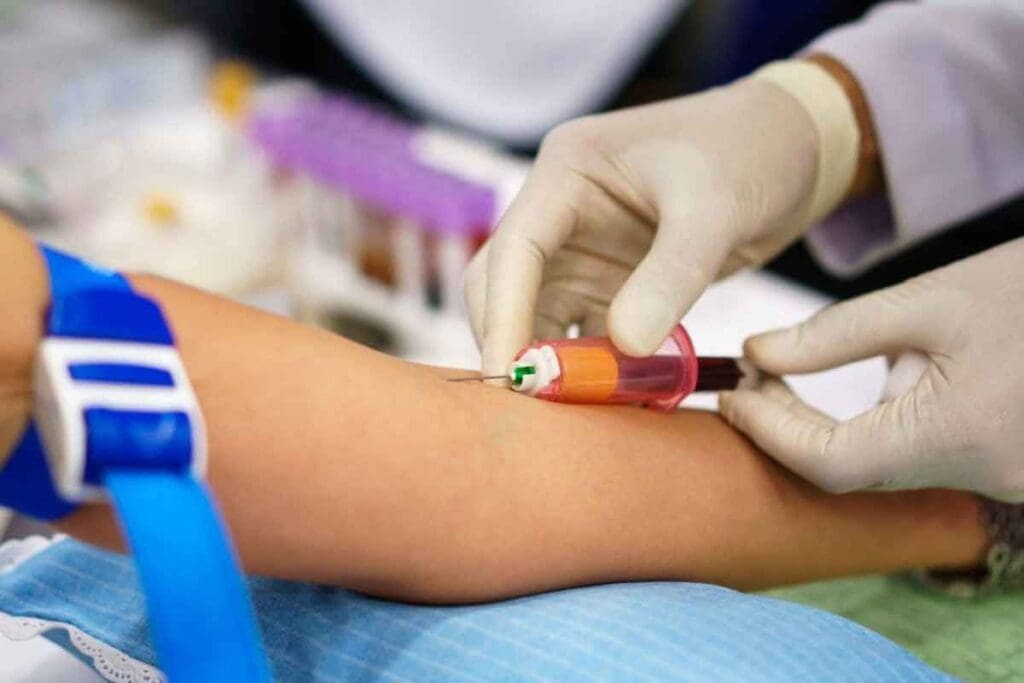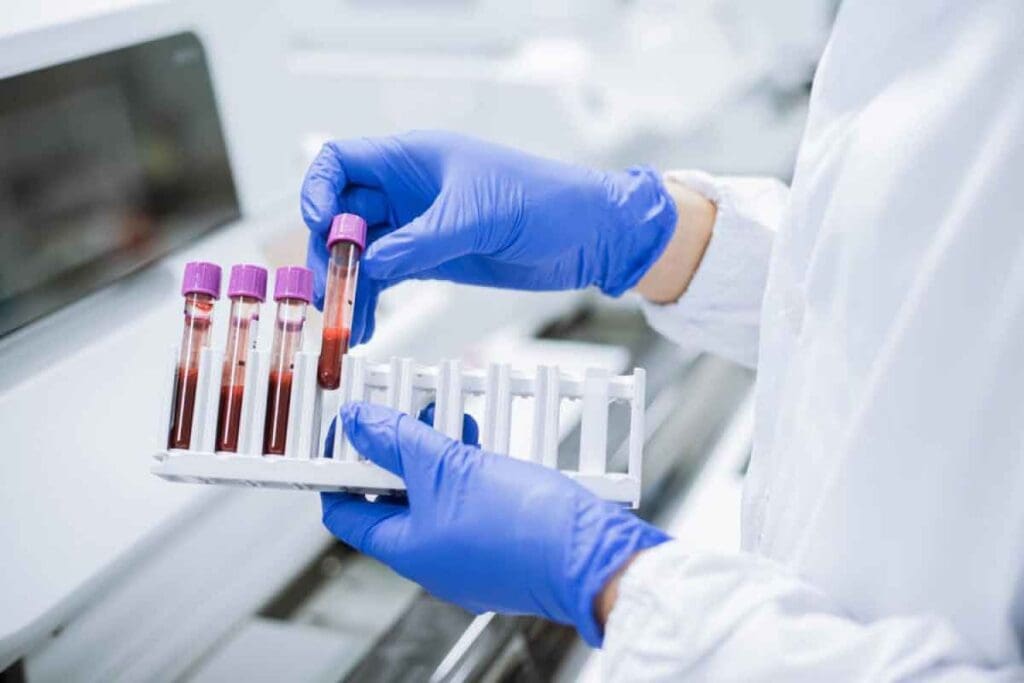Last Updated on November 14, 2025 by Ugurkan Demir

Hemoglobin is a key protein in red blood cells. It carries oxygen all over the body. At Liv Hospital, we stress the need to know about hemoglobin levels, what is the normal level for haemoglobin, and their role in health.
Having a normal hemoglobin level is key for getting enough oxygen to tissues. If levels are off, it can cause health problems. So, it’s important to understand the normal range and why it matters.
We will look into how hemoglobin levels are checked and what’s considered normal. This will help you grasp your health better and make smart choices.

Hemoglobin is key in moving oxygen from the lungs to the body’s tissues. It’s a complex protein found in red blood cells (RBCs). This protein allows oxygen to be carried all over the body.
Hemoglobin is vital for delivering oxygen to the body’s tissues. Its special shape lets it grab oxygen in the lungs and release it in the tissues.
Hemoglobin is essential for moving oxygen. It binds oxygen in the lungs and lets it go in the tissues. This is key for the body’s energy needs, as oxygen is needed for making energy.
Red blood cells are where hemoglobin lives in the body. Each RBC is packed with about 270 million hemoglobin molecules. This is important for moving oxygen. The RBCs’ flexible membranes and lack of a nucleus help them hold lots of hemoglobin.
Having 270 million hemoglobin molecules in each RBC shows how important these cells are. This number helps the body send oxygen to tissues well. It supports many body functions.
It’s important to know what a normal hemoglobin level is in adults. This helps doctors diagnose and treat health issues. Hemoglobin is a key protein in red blood cells that carries oxygen.
Adult males usually have a hemoglobin level between 14 to 18 g/dL. This is because they generally have more muscle and higher testosterone levels than women.
For adult females, the normal hemoglobin level is 12 to 16 g/dL. This range is based on the average blood volume and red blood cell count in healthy women.
Comparing hemoglobin levels of 12 g/dL and 16 g/dL shows that both are within the normal range. But they are at different points for males and females. A level of 12 g/dL is at the lower end for females, while 16 g/dL is normal for both, leaning towards the higher end for females.
Doctors need to understand these values to decide if more tests or treatment are needed. For example, a hemoglobin level of 12 g/dL in a male might suggest a problem, but it’s normal for a female.
Hemoglobin is key to oxygen transport in our bodies. It’s a protein in red blood cells that carries oxygen from the lungs to our tissues. This is vital for our metabolic activities, as oxygen is needed for energy production.
Hemoglobin is essential for oxygen transport in the body. Its unique structure lets it bind oxygen in the lungs and release it in tissues. This is critical for our health, as oxygen is needed for many cellular processes.
Red blood cells, or erythrocytes, are where hemoglobin is mainly found. Each red blood cell has a lot of hemoglobin. This lets it carry oxygen well.
It’s amazing that each red blood cell has about 270 million hemoglobin molecules. This shows how well these cells can transport oxygen. The high amount of hemoglobin in red blood cells helps deliver lots of oxygen to our tissues.
The large number of hemoglobin molecules in each red blood cell shows how important hemoglobin is. It highlights the complex and specialized role of red blood cells in our health.
The normal hemoglobin range for adults changes based on gender. Knowing these differences is important for understanding blood test results. Hemoglobin levels are a key part of a complete blood count (CBC) test. Healthcare providers use this test to check overall health and find various conditions.
Adult males usually have a hemoglobin range of 14 to 18 grams per deciliter (g/dL). This range might vary slightly between labs, but generally stays the same. A hemoglobin level in this range means the body has enough red blood cells to carry oxygen to tissues and organs well. If levels are lower, it could mean anemia or other health problems that need medical help.
For adult females, the normal hemoglobin range is between 12 and 16 g/dL. Like males, this range can vary a bit depending on the lab. Healthcare providers must consider these ranges when looking at test results and making diagnoses. Things like menstrual cycle, pregnancy, and overall health can affect hemoglobin levels in women.
Understanding hemoglobin levels means knowing the context of the test results. For example, a hemoglobin level of 12 g/dL is normal for women but on the lower side. A level of 16 g/dL is normal for both men and women, showing healthy red blood cell levels. Knowing these values helps doctors diagnose and manage conditions related to abnormal hemoglobin levels.
Keeping hemoglobin levels in the normal range is key to good health. Both low and high hemoglobin levels can signal health issues that may need medical attention and treatment.
Hemoglobin levels change a lot as we age, from babies to seniors. These changes are important for making the right diagnosis and treatment. It’s key to know how hemoglobin levels shift as we grow up.
Newborns have more hemoglobin than adults. Newborns have hemoglobin levels ranging from 14 to 24 g/dL, averaging about 17-18 g/dL. This is because they need more oxygen before birth. After birth, their levels drop as they grow.
Children’s hemoglobin levels change as they grow. By 6 months of age, the range starts to settle. For kids between 1-12 years, the normal range is 11-13.5 g/dL. This can vary a bit based on age and sex.
In older adults, hemoglobin levels can be affected by many things. This includes diet, chronic diseases, and changes in the bone marrow with age. Generally, hemoglobin levels in older adults can be slightly lower than in younger adults. For seniors, a hemoglobin level above 12 g/dL is usually okay. But, this can change based on health and chronic conditions.
It’s vital for doctors to know the normal hemoglobin ranges for each age group. This helps them diagnose and treat conditions related to hemoglobin levels better. We must take these age-related changes into account when looking at blood test results to give the best care.
Hemoglobin levels are measured in grams per deciliter (g/dL). This unit helps doctors understand blood health. It’s key for diagnosing and managing health issues.
The g/dL measurement is a common standard in medicine. It shows how much hemoglobin is in the blood. Normal hemoglobin levels differ from person to person. Knowing these levels helps spot conditions like anemia or polycythemia.
Hematocrit is another key measure, showing the red blood cell proportion. Along with hemoglobin, it gives a full view of blood health. Understanding these measurements is vital for a detailed blood health assessment.
Hematocrit levels differ between men and women. Men usually have a range of 40% to 54%, while women’s range from 37% to 48%. These numbers can change based on lab standards. Knowing these ranges helps spot issues with red blood cell counts.
Doctors use hemoglobin and hematocrit to understand blood health. This knowledge helps them make better diagnoses and treatments.
The right amount of hemoglobin varies by age, sex, and health. Hemoglobin is a protein in red blood cells that carries oxygen. Keeping hemoglobin levels in check is key for good health.
Having the right amount of hemoglobin is vital for oxygen delivery to the body’s tissues. For adults, the normal range is 14-18 g/dL for men and 12-16 g/dL for women. But these numbers can change slightly based on the lab.
Optimal hemoglobin levels are more than just being within a normal range. They’re about having enough hemoglobin to meet the body’s needs. People with certain health issues or who are very active might need different levels.
Hemoglobin levels differ across various groups. For example, newborns have higher hemoglobin levels that decrease as they grow. Children and the elderly also have different levels due to their unique physiological changes.
For athletes, the right hemoglobin level is essential for top performance. It helps muscles get the oxygen they need to perform at their best. Studies show that athletes might benefit from slightly higher hemoglobin levels for endurance sports.
But it’s important to remember that too much or too little hemoglobin can harm health. So, keeping hemoglobin levels in check is vital for health and peak performance.
It’s important to know what affects hemoglobin levels. This helps keep our red blood cells healthy. Many things, like our body, environment, and lifestyle, can change hemoglobin levels.
Our body’s health affects hemoglobin levels. For example, chronic diseases like kidney disease or cancer can change how much hemoglobin we make. Hormonal changes and genetic disorders also play a part.
Everyone’s body is different. So, it’s key to check hemoglobin levels often, even more so if you have health issues.
Where we live can change our hemoglobin levels. At high altitudes, our body makes more red blood cells to handle less oxygen. This is important for people living or visiting high places.
Other things, like pollution and toxins, can also affect our hemoglobin. Knowing about these can help us stay healthy.
What we eat and do affects our hemoglobin. Eating foods high in iron, vitamin B12, and folate is key. Foods like red meat, spinach, and fortified cereals help.
Exercise is good for our hearts and can change hemoglobin levels. But too much exercise can be bad. So, finding the right balance is important.
Our lifestyle choices, like smoking and drinking too much alcohol, can hurt our hemoglobin. Quitting smoking and drinking in moderation can help keep our hemoglobin healthy.
Keeping hemoglobin levels healthy is key for good health. Knowing what normal levels are helps avoid anemia and other problems. We talked about how hemoglobin carries oxygen, its usual levels in adults, and what affects these levels.
To keep hemoglobin levels healthy, knowing the normal range is important. Things like diet, exercise, and lifestyle also play a part. Taking care of these can help keep hemoglobin levels in check.
Regular health checks and a balanced lifestyle are vital for healthy hemoglobin. This approach helps prevent health issues and keeps you feeling your best.
Adult males usually have hemoglobin levels between 14-18 g/dL. Adult females have levels between 12-16 g/dL.
Hemoglobin is a protein in red blood cells. It carries oxygen to all parts of the body. This is key for keeping tissues well-oxygenated.
Each red blood cell has about 270 million hemoglobin molecules.
Hemoglobin shows how much hemoglobin is in the blood. Hematocrit shows the red blood cell percentage. Together, they give a full view of blood health.
Hemoglobin levels change with age. Newborns have high levels, which drop in children. In adults and the elderly, levels vary.
Good hemoglobin levels for top physical performance depend on individual factors. But, they usually fall within the normal adult range.
Many things can change hemoglobin levels. This includes age, environment, altitude, diet, exercise, and lifestyle.
Hemoglobin is measured in grams per deciliter (g/dL).
At high altitudes, the body makes more hemoglobin. This helps adapt to lower oxygen levels.
Males usually have a hematocrit range of 40-54%. Females’ ranges are generally lower, but vary.
A level of 12 is near the low end for females. A level of 16 is normal for both males and females. It shows good oxygen-carrying ability.
Subscribe to our e-newsletter to stay informed about the latest innovations in the world of health and exclusive offers!